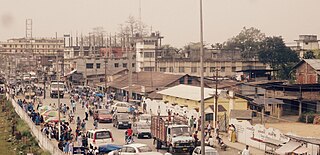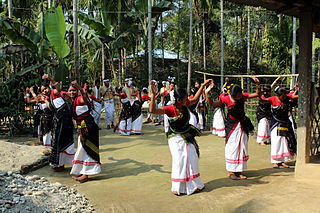Related Research Articles

Mājuli or Majuli is a large river island located in Assam, India. It is formed by the Brahmaputra River to the south and east, the Subansiri River to the west and an anabranch of the Brahmaputra River called Kherkutia Xuti to the North.

Dibrugarh district (Pron:ˌdɪbru:ˈgor:) is a district in the state of Assam in India. The district headquarters are located within the city of Dibrugarh.

Namrup is a small town situated close to the foothills of the Patkai Hills in the extreme southeastern part of Assam, India. The river Dihing or Disang flows through it. Namrup is situated in amidst wet-paddy fields, indigenous Assamese villages, orchards, large tea-gardens and densely forested hills. Administratively Namrup is located within Dibrugarh district and is today an important industrial town of Assam. Namrup is approximately 75 km from Dibrugarh by road towards the south-east and approximately 50 km from Tinsukia towards the south. It is also a small railway station in Dibrugarh-Guwahati broad-gauge railway line. The nearest airport is Dibrugarh located at a distance of approximately 70 km. Other urban areas close to Namrup are Naharkatiya - 18 km, Duliajan - 35 km, Sonari - 20 km, Moran - 55 km, etc. by roadways. Namrup is located around 500 km east of Guwahati, the largest city in the North East Region.

The Moamoria rebellion (1769–1805) was an 18th-century uprising in Ahom kingdom of present-day Assam that began as power struggle between the Moamorias (Mataks), the adherents of the Mayamara Sattra, and the Ahom kings. This uprising spread widely to other sections of Ahom kingdom including disgruntled elements of the Ahom aristocracy leading to two periods in which the Ahom king lost control of the capital. Retaking the capital was accompanied by a massacre of subjects, leading to a steep depopulation of large tracts. The Ahom king failed to retake the entire kingdom; a portion in the north-east, Bengmara, became known as Matak Rajya ruled by a newly created office called Borsenapati, became a tribute-paying but virtually independent territory.
Moranhat is a town and a town area committee in Charaideo district in the Indian state of Assam.The town is divided by N.H 37 into Charaideo and Dibrugarh district.

Naharkatia is a town and a Municipal board in Dibrugarh district in the Indian state of Assam. It is well known for petroleum and gas reserves. Earlier, Duliajan, the head office town of Oil India Limited was in its circle. However, the towns are close, within a 30-minute journey.

Sutanphaa also Siva Singha was the 31st king of Assam from the Ahom dynasty who reigned from He was the eldest son of King Rudra Singha. Siva Singha was with his dying father at Guwahati, who then proceeded to the capital Rangpur where he ascended to the throne. He is noted for his elaborate system of espionage. He had numerous temples erected and made large gifts of land to them. With his patronage, Hinduism became the pre-dominant religion of the Ahoms. The king was also a patron of music and literature and music and himself composed Sanskrit songs and learnt songs. His reign coincided with the arrival of the first Europeans traders into Assam.

Assam is the main and oldest state in the North-East Region of India and as the gateway to the rest of the Seven Sister States. The land of red river and blue hills, Assam comprises three main geographical areas: the Brahmaputra Valley which stretching along the length of the Brahmaputra river, the Barak Valley extending like a tail, and the intervening Karbi Plateau and North Cachar Hills. Assam shares its border with Meghalaya, Arunachal Pradesh, Nagaland, Manipur, Tripura, Mizoram and West Bengal; and there are National Highways leading to their capital cities. It also shares international borders with Bhutan and Bangladesh and is very close to Myanmar. In ancient times Assam was known as Pragjyotisha or Pragjyotishpura, and Kamarupa.

Satra are institutional centers associated with the Ekasarana tradition of Vaishnavism, largely found in the Indian state of Assam and neighboring regions. Numbering in the hundreds, these centers are generally independent of each other and under the control of individual adhikara, though they can be grouped into four different Sanghati (orders).
Narayanpur is a town located in Lakhimpur district of the northeastern Indian state Assam. It falls under Bihpuria constituency of Assam Legislative Assembly and under Narayanpur Police Station. Narayanpur is also the name of the development block. It is located between Dholpur and Bihpuria. Narayanpur was the birthplace of Madhavdev.
Boiragimoth is a suburb of Dibrugarh city in Assam, consisting of several residential neighbourhoods and local markets. It is considered one of the most popular residential areas in the town, with shops, restaurants, schools, colleges, boarding houses, places of worship, sports facilities, and so on.

Barpeta Satra is a well-known sattra situated at Barpeta in the Indian state of Assam. It was established by vaishnavite saint Madhabdev in 1505 shakabda. The earlier name of the satra was Barpeta Than.

Garh Doul archaeological site is an important State Protected Monument in Assam, India, situated at Tarajan Kumargaon and about 7 kilometres (4.3 mi) away from Tezpur, Sonitpur district. The archaeological site is listed as an ASI monument under number S-AS-95. This is fortified in all direction reinforced rampart and covers an area of 250×250 m. The site has two brick mounds, which contains the foundation of brick temple plinths. The remains are datable to 7th and 8th century CE.
Assam – 16th largest, 15th most populous and 26th most literate state of the 28 states of the democratic Republic of India. Assam is at 14th position in life expectancy and 8th in female-to-male sex ratio. Assam is the 21st most media exposed states in India. The Economy of Assam is largely agriculture based with 69% of the population engaged in it. Growth rate of Assam's income has not kept pace with that of India's during the Post-British Era; differences increased rapidly since the 1970s. While the Indian economy grew at 6 percent per annum over the period of 1981 to 2000, the same of Assam's grew only by 3.3 percent.
The Brittial Bania/Bania is an ethnic community in Assam, India. The group traces its roots to a merchant community who reached Assam (Kamarupa) in ancient times. Some historians claim that after the Austric group migrated to ancient Assam, the next group of people who arrived was the Dravidian group, who are represented by the Bania and Kaibbartas today. Unlike the mainland Baniya community, this community of Assam is recognized as a Scheduled Caste by the government of India.

The Moran are an ethnic group found in the northeast Indian states of Assam and Arunachal Pradesh. They are of Tibeto-Burman origin and belong to the Kachari family. They speak Assamese language, though they used to speak Moran language which was alive until the early 20th century and was closely related to the Dimasa language. They once shared the same allied customs with other Kachari groups, but after their conversion to Vaishnavism, the customs began to diminish, but still, those customs can be seen intermixed with Vaishnavism.

Bordowa 'Batadrava' Than is a holy pilgrimage site in Nagaon, Assam. It is located in the birthplace of the great Assamese saint and social reformer Srimanta Sankardev. Sankardev at the age of 19, established the Bordowa Than in 1468, it is also the first Namghar or Than constructed. The rituals of this Than is conducted according to the norms of Purush sanghati. The pilgrimage site is located at Batadrava, about 16 km from Nagaon city and it covers an area of 16 bigha.

Sri Sri Auniati Satra is a satra or monastery located in the Majuli river island in Assam, India, that adheres to the Brahma Sanghati of the Ekasarana Dharma, a socio-religious and cultural movement initiated by Srimanta Sankaradeva, who was born in 1449 CE. It is one of the four "raj satras" or royal satras associated with the Ahom dynasty. It is the first satra patronised by the kingdom. It is usually believed that this satra was established in the year 1653 CE, with the initiative of Ahom king Jayadhwaj Singha, the first head monk or satradhikar being Sri Sri Niranjana Deva Goswami, even though different opinions exist.

Raidongia Doul or Raidongia Dol is a historical doul located in the Lejai-Kalakhowa area of Dibrugarh district. It was built in 1750 by the Ahom king Swargadeo Pramatta Singha (1744–1751). Initially it was a Devi Temple. Over time, a house was built near the doul and the people of the area started to worship Shiva. Therefore, the present doul is also known as Shiv Doul or Raidongia Shiv Doul. Its main festival is Maha Shivratri. The Archaeological Department of the Government of Assam has recognized the Raidongia Doul as a State Protected Monument.

Bezor Doul or Bez Doul is a historical monument located at Bezor pothar in the Dhemechi area of Dibrugarh district. It is situated about 5 km from Dimow town of Sivasagar district. The Bezor Doul is a Vishnu Doul and is built with an octagonal sanctuary and a steep gap. It is an example of late medieval brick temple architecture from the Ahom period. During the Ahom era, a traditional medicine practitioner of Chung Khel received the title of Bezbarua for his efficiency. He was granted vast lands by the Ahom kings in the present-day Bezor pothar area. The doul was constructed by the Ahom king Rudra Singha in his memory. The walls of this small doul are quite thick. Various flower jali works adorned the walls of the doul, but they are no longer present. There are no idols in this doul, but Vishnu is still worshipped here. The Archaeological Department of the Government of Assam has recognized the Bezor Doul as a State Protected Monument.
References
- ↑ "Protected Archaeological Sites and Monuments - (104) Moiramora Doul, Khamtighat, Dibrugarh District". Archeological Survey of India. Retrieved 8 April 2024.
- ↑ "Protected Monuments in Assam". Archeological Survey of India. Retrieved 8 April 2024.
- ↑ Nabajit Deori, Chabina Hassan. Preliminary Report of the Excavation Conducted at Moiramora Archaeological Site Dibrugarh District of Assam 2017-2018 (Report). Government of Assam. p. 3-7. Retrieved 13 April 2024.
- 1 2 "Moiramara samples sent for dating". The Telegraph. Retrieved 13 April 2024.
- ↑ "Archaeologists to send samples of ancient temple ruins at Dibrugarh's Jokai for OSL". Northeast Now. Retrieved 13 April 2024.